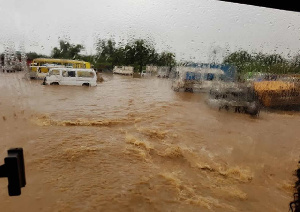Opinions of Friday, 27 May 2022
Columnist: Philip Kyeremanteng
Ghana Government must improve the drainage system in Accra
Perennial flooding in the city has become a festival celebrated by the people of Accra who live in Flood-Prone Areas. It is celebrated from March to June annually since the 1960s.
On June 3, 2015, a flood in Accra followed by a filling station gas explosion killed 150 people. The disaster also affected more than 50,000 residents in Accra. The cost of the damage was estimated at Gh₵ 242 million or 55 million US dollars.
Rapid urbanisation and population influx have intensified the city capacities and services around Accra. Of its many challenges are urban flooding and solid waste management.
A simple public service is often lacking in Accra and the two sectors interact as solid waste blocks drainage flows, resulting in floods during rainfall.
Accra is expanding at a rate much faster than flood risk management plans are developed and infrastructure installed.
The existing systems are additionally not furnished to accommodate changing and increasing runoff patterns caused by climate change and increase in impervious areas.
These pressures are experienced by the informal settlements in Accra, where impromptu dwellings often expand into flood risk areas, low-lying areas, or existing drainage channels.
Less than an estimated 30% of Accra waste is collected, this is because of the lack of waste collection services. People resort to dumping waste into nearby drains, waterways, and open spaces.
Open dumpsites inside drains or waterways overwhelm an already stressed drainage system, increasing the frequency and severity of urban flooding. Annual floods in Accra are blamed, at least in part, on plastic bags, which block sewers and drains.
Poor drainage and contamination of urban runoff pose numerous concerns. Stagnate water caused by disposed plastics or clogged drainage channels acts as a breeding or feeding grounds for vectors, and vermin, increasing the risks of communicable diseases in densely populated environments.
These pressures compound more intensely in impoverished urban areas in Accra; the poor have the least access to public services and have the least capacity to prepare for and rebuild after disasters, placing them in a vicious cycle of poverty.
If solid waste management and urban flood risk management are so critical, why are not these services being provided? Awareness of health and sanitation issues is generally low both in government and among residents.
Waste management is often seen as a low-status occupation with low wages, leading to a lack of investments.
No single approach will ever be universally successful to address this recurrent problem. Addressing this inter-sector issue requires a combination of actions that suits that locality, involving various actors, including community members, the private sector, and AMA. This is achievable because it's not rocket science!
Proposed Solutions
1. Public Involvement and Education
Collaboration between AMA and Residents, Community Groups, Industries, and Private companies to form the foundation is necessary. Investment in the public involvement and education sector helps address the interplaying issues surrounding waste accumulation in drainages that extend beyond a city government’s capacity to manage at any moment in time. Specifically, investment in this sector addresses the following two needs.
Residents and Industries need to take initiative and responsibilities, within their capacity, to create the society or community in which they prefer to live.
Residents, Industries, and the City government need to collaborate and work under a common purpose or understanding public involvement is time and energy-intensive, requiring activities such as holding meetings and workshops, and maintaining open communication channels, which can slow down decision-making processes and project execution.
However, projects that have resident support are more sustainable. Similarly, investments in relationship building and nurturing residents that take initiative and responsibility for their immediate surroundings have immeasurable benefits over the long term. Benefits of public involvement include but are not limited to the following.
Raises residents’ awareness, motivation, and sense of autonomy.
Builds relationships between residents and the government for smoother
communication and collaboration in the future.
Nurtures trust that improves sustainability and ease of implementing projects
and city activities.
Provides the government with resident feedback and ideas to improve city
services and programs.
Helps ensure the longevity of projects and programs.
Promotes co-production, where resident activities are functional components of
city services, such as cleaning out local gutters and drainage channels.
Separating or putting out the waste for city services to collect, treat, and dispose or recycle. Identifying issues, such as accumulated waste or blocked drainage, and reporting it to proper authorities.
The intent is not necessary to exclude other possible stakeholders, such as private businesses and community organisations.
2. Solid Waste Management
To address the interplay of domestic solid waste and urban flood risk, the city of Accra needs to first and foremost establish waste collection and transport systems.
If domestic waste is effectively removed from the city landscape, it would prevent any from accumulating and blocking city drainage systems, which causes flooding and public health issues.
Citywide services are critical to providing residents with a clear way to dispose of waste generated. However, if a city is to collect waste, there needs to be a place for the waste to go.
Hence, investment in waste collection and transport must inherently include investment in the entire waste stream. The most simple and quickest approach is to establish a modern landfill, where waste can be responsibly disposed of in a manner that minimises environmental and health risks.
However, waste management services that lead to waste disposal are neither best practice nor the most socially or environmentally sustainable.
This linear system waste where raw materials are extracted from the environment to produce a product, which may be used once and then dispose it in a landfill at the end. Such a system constrained the environment and city services.
Circular Economy thinking provides sustainable alternatives by focusing on prevention, minimisation, or reduction of resource use and by identifying opportunities to reuse, recycle, or recover resources. from waste.
Reducing environmental and resource demands throughout the product life cycle also helps reduce emissions of greenhouse gases and mitigate climate change.
3. Combined sewer systems are sewers (CSS)
Are designed to collect rainwater runoff, domestic sewage, and industrial wastewater in the same pipe.
Most of the time, combined sewer systems transport all their wastewater to a sewage treatment plant, where it is treated and then discharged to a water body.
During periods of heavy rainfall, however, the wastewater volume in a combined sewer system can exceed the capacity of the sewer system or treatment plant.
For this reason, combined sewer systems are designed to overflow occasionally and discharge excess wastewater directly to nearby streams, rivers, or other water bodies.
In comparison, separate sewer systems (SSS) provide separate networks for the two discharge streams. Impervious areas, however, significantly reduce infiltration and increase surface runoff, which collects in gutters and drainage channels as stormwater or in ponds or detention basins.
Detention basins provide storage of runoff and an opportunity for infiltration, helping to decrease flows within the urban drainage system and receiving natural waterbodies.
Runoffs enter underground pipes that carry domestic wastewater, which requires treatment before being discharged into a nearby water body.
There can be underground storage to control flow throughout the system, accommodate times of high flow, and reduce combined sewer overflows (CSOs).
CSOs are untreated discharges from CSS, necessary to prevent upstream flooding, but detrimental to the water quality and environment of the receiving water body.
Waste that accumulates in these structures can restrict runoff from entering the urban drainage system and cause floods. At the same time, in developing countries, urban drainage infrastructure capacity itself is usually inadequate to cope with runoff.
Addressing systemwide urban drainage challenges requires examining the entire system in Accra. This solution does not present a holistic approach to urban drainage planning and design but provides some suggested actions for a rapidly growing city, explaining important considerations when expanding or improving existing urban drainage systems.
4. Sustainable Urban Drainage Systems
Better known as SUDS – are designed to lower the risks of flooding in any area by creating more efficient means of draining water from areas prone to flooding without over-filling our existing drainage system.
A significant contributor to the issue of flooding is the continual expansion and densification of urban areas.
These town and city areas tend to be built up using great expanses of impermeable materials which prevent rainwater from draining away as it falls, and this has become a major factor in the floods which have befallen the Accra in recent years.
Our old drainage systems simply can’t cope with the amount of rain they’re expected to handle.
What does a Sustainable Urban Drainage System do?
• Slow down the rate at which rainwater flows into our older drainage systems
• Improve the quality of rainwater flowing into the drains
• Reduce the damage caused to the environment & wildlife habitats by heavy
rainfall
To achieve these three main aims, SUDS implements several different measures:
Creation of more permeable surfaces. The improvement of drainage and the reduction of the risk of flooding are dependent upon the introduction of permeable outdoor surfaces.
More permeable surfaces include gravel, blocks, or tiles with spaces left between them to allow for drainage through to a layer of soil. This SUDS method has many applications and is popular with many kinds of property.
For this to work, the underlying soil must also be permeable, so a heavily clay-based soil is no good. The soil also needs to be clean and contaminant-free to avoid any harmful substances being washed into another body of water where it could cause environmental damage.
Rainwater harvesting. There are several good reasons to harvest rainwater rather than allowing it to wash away. Preventing rainwater from getting to the drains both reduces the risk of flooding and saves that water for practical uses around the home. Rainwater is great for use in washing, cleaning, gardening, and toilet flushing.
Whether using a simple water butt in the garden or a more complex underground rainwater harvesting system, there is plenty that can be done with water saved from running off the roof and into the drains.
Formation of ditches, ponds, and wetlands. Sometimes, a more obvious landscape feature can be used to prevent flooding. Manmade ponds, ditches, and wetlands can effectively control the rate at which water drains away from a densely built-up area.
Water is collected and then gradually released by a process known as attenuation. When completely drained, these spaces blend into the wider landscape and are usually covered with grass or other vegetation.
Green Roofing. A relative newcomer to the building site, green roofs are sprouting all over the place. Although they have been used throughout history, they have recently enjoyed something of a renaissance as designers strive to become more environmentally responsible in their practices.
Whilst green roofs slow down the rate at which water reaches the ground and drainage systems, they also provide other advantages such as air purification wildlife habitat, and home insulation.











